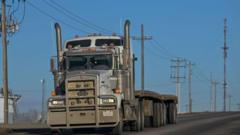The trucking industry is undergoing a significant transformation as digital technologies reshape how drivers find work and manage their routes. Jared, a Canadian truck driver with over two decades of experience, reflects on his shift from transporting perishable goods to hauling equipment for big-name music tours. Modern technology allows him to connect with clients quickly through various devices in his truck's cabin, a far cry from the days of payphones and pagers.
However, these advancements come with drawbacks. Instead of increased earnings, Jared notes a marked decline in per-mile pay—averaging $1.10 today compared to $3 during the pandemic. The introduction of "Uberised" platforms, which link truckers to freight opportunities, has led to increased competition and wage stagnation. Christopher Monette, representative of Teamsters Canada, has raised concerns that the digital transition is harming fair labor standards, especially for smaller carriers struggling to compete.
Despite these concerns, companies like Uber Freight promote their platforms as beneficial, offering flexibility that empowers drivers to set their rates. Meanwhile, Vancouver's Freightera is challenging the industry status quo by allowing drivers to set their own prices based on their needs, a move hailed as a positive step toward supporting independent truckers.
As trucking increasingly adapts to digital logistics, experts like Eric Beckwitt envision a future where artificial intelligence streamlines operations, potentially leading to an automated freight industry. Still, the fear of job displacement lurks, with autonomous trucks already being tested in various locations.
Globally, countries like Kenya have embraced digital solutions, improving freight efficiency and reducing costs. The aim is to minimize idle time and optimize routes to reduce both operational costs and carbon emissions.
While technology promises to enhance the trucking industry, professionals like Jared remain skeptical about the future, emphasizing the need for fair labor practices amid this rapid evolution.
However, these advancements come with drawbacks. Instead of increased earnings, Jared notes a marked decline in per-mile pay—averaging $1.10 today compared to $3 during the pandemic. The introduction of "Uberised" platforms, which link truckers to freight opportunities, has led to increased competition and wage stagnation. Christopher Monette, representative of Teamsters Canada, has raised concerns that the digital transition is harming fair labor standards, especially for smaller carriers struggling to compete.
Despite these concerns, companies like Uber Freight promote their platforms as beneficial, offering flexibility that empowers drivers to set their rates. Meanwhile, Vancouver's Freightera is challenging the industry status quo by allowing drivers to set their own prices based on their needs, a move hailed as a positive step toward supporting independent truckers.
As trucking increasingly adapts to digital logistics, experts like Eric Beckwitt envision a future where artificial intelligence streamlines operations, potentially leading to an automated freight industry. Still, the fear of job displacement lurks, with autonomous trucks already being tested in various locations.
Globally, countries like Kenya have embraced digital solutions, improving freight efficiency and reducing costs. The aim is to minimize idle time and optimize routes to reduce both operational costs and carbon emissions.
While technology promises to enhance the trucking industry, professionals like Jared remain skeptical about the future, emphasizing the need for fair labor practices amid this rapid evolution.




















